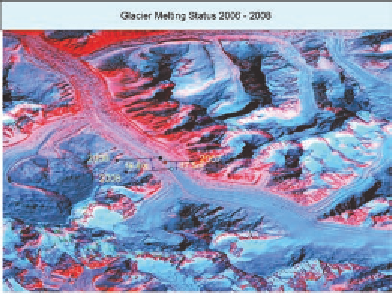Environmental Engineering Reference
In-Depth Information
Figure 2. Use of Remote Sensing technology for
analysing glacial changes in the Himalayas
significantly greater frequency including real time
information. Besides this an AWS also provides
data in all weather, day and night, 365 days per
year and can be installed in extremely remote and
sparsely populated areas.
Different users of AWS have different require-
ments. These include:
•
Short-term projects (e.g. animal health
emergency monitoring or near wild fires),
some are installed for long-term projects
(e.g. studying climate change)
•
Real time data (e.g. for irrigation), some
provide delayed reports (e.g. for climate
monitoring)
land cover of a region which provide very useful
formation on extent of glacial surface area/volume
etc.
•
All weather monitoring (e.g. for cyclone
forecasting), some do not (e.g. crop disease
monitoring).
Automatic Weather Stations
A common set of conditions for all the above
is that data must be representative of the area and
time period under investigation, and that the data
must continually meet the accuracy required. In
addition, the data collection and storage systems
must be cost effective and must also be considered
before AWS purchase.(Bureau of Meteorology,
Australian Government)
One of the key attributes of a good Automatic
Weather station is the use of suitable sensors to
record and monitor various weather parameters.
The Bureau of meteorology, Australian Govern-
ment has provided some indicators of the various
types of sensors which can used to effectively
monitor weather data.
Choosing sensors appropriate to the user's
requirements an important part of monitoring
weather related information. This is also dependent
on the type of research project that is being under-
taken. The Bureau's standard AWSs use sensors
to monitor temperature, humidity, wind speed and
direction, pressure and rainfall. Various advanced
sensors are available for specialised applications.
These sensors can monitor cloud height, visibility,
Recent advances in communication technologies
have greatly helped understand the behaviour and
dynamics of glaciers at high altitude under adverse
climatic conditions. The use of a state of the art
Automatic Weather Station (AWS) monitors the
characteristics of high altitude Himalayan glaciers
through real time data recording and monitoring.
Using tools like AWS, research on glacial melt
patterns of large glaciers like the Gangotri glacier
in the Himalayas is better understood.
The AWS installed for glacier studies records
data on various parameters through a data logger
which can then be downloaded for analysis. The
various parameters for which data is collected and
analysed includes barometric pressure, tempera-
ture, humidity, rain, wind speed, wind direction,
wind chill factor, dew point, heat index and UV
and solar radiation. A field team is normally based
at the glacier for this purpose to study the relation-
ship between glacial ablation and temperature.
The use of AWS is necessary as it is consistent
in the measurements of multiple weather param-
eters. The data from an AWS is also available at a

